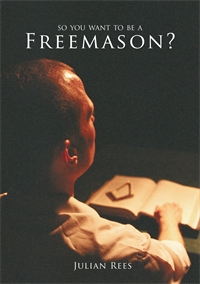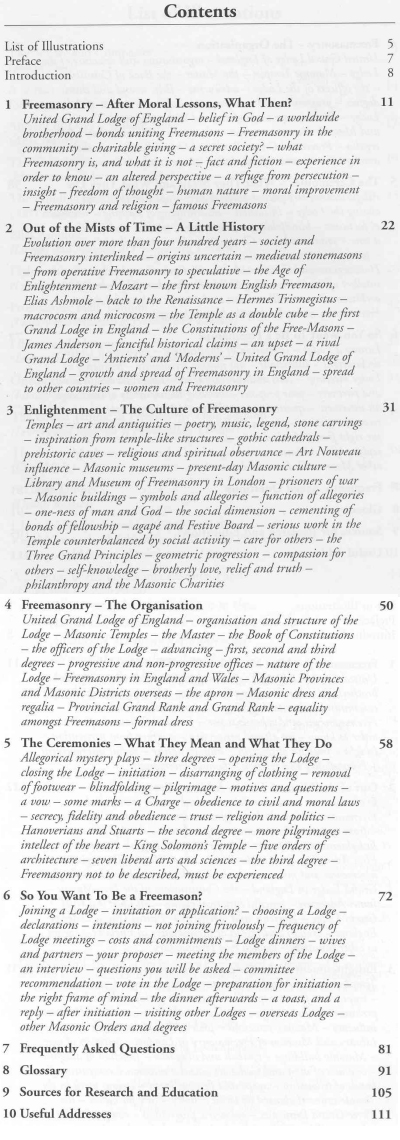
Introduction by Julian Rees:
So, you are interested in Freemasonry? Let's talk about it in broad outline first -nothing too involved to start with. We will assume your interest isn't merely academic; there are plenty of books dealing with the academic side of Freemasonry, and this book is not one of them! Nor is it likely that you are reading this out of idle curiosity. Your interest may be centred on the idea of becoming a Freemason yourself. This could be quite a big step, so before you set the wheels in motion, you would probably agree it's best to mark out the ground -layout a sort of plan, a plan featuring you, a plan featuring Freemasonry, and then, if you want to go further, a plan putting the two together.
A plan about you first, since you are the most important person in this endeavour. You might like to establish what it is about Freemasonry that aroused your interest in the first place. The plan also needs to show where you are in your life. Are you single? Are you married or in a long-term stable relationship? What are the demands of your career that might have an influence on taking up avocation as important as Freemasonry? Although Freemasonry will take as much or as little of your time as you
decide, it is a vocation. Will it impact on your hobbies and non-career pastimes? Once you have read this book, you will be able to answer these and other questions.
What was it about Freemasonry that first attracted your interest? Are you interested in it as a means of enriching your social life? Do you believe that adherence to principles will help you to develop your character, and thereby to further your personal development, and through that to enhance your career possibilities? Are you of a philanthropic nature, keen to become involved in charitable causes and generally to be of service to humankind? Are you looking to Freemasonry to give more spiritual dimension to your life? Anyone of these would be a valid motivation for becoming a Freemason and many who come to Freemasonry are seeking to expand more than one of the above aspects of their life. You may like to consider this -Freemasons are not better than other people, but they do believe that Freemasonry can help them to become better than they are. This aspect is important. An organisation that claimed its members to be somehow superior to the rest of society would be a dull organisation indeed.
Imagine for a moment that you are planning to marry, or applying for a job, or enrolling for a course of study, or even just planning a holiday; you would not do any of these things without first satisfying yourself regarding the suitability of what you were doing, and exploring the benefits and the drawbacks of your course of action. So it is with joining Freemasonry, an endeavour which is possibly as important as any of the above, and more important, certainly, than planning a holiday! If all goes well, this book will enable you to map out the landscape, to see clearly where you are going.
Although there is a marked social dimension to Freemasonry, the ancient art is more than that. It requires a degree of commitment; not so much in time or money, as a commitment to its ideals, ideals of brotherhood, of humility, of unity, of morality, of mutuality, of humanity and of tolerance. As much as each individual Freemason gives to the Craft, so he or she will receive from it in equal, or greater, measure. Freemasonry is there to promote the above ideals, and it does so in away that is free from religious doctrine or political or ideological persuasion. Consider this: Freemasonry has gone hand in hand with threads of history throughout the past three centuries. The founding fathers of the United States of America counted many Freemasons among their number. The Age of Enlightenment, the most important intellectual development in Europe since the Renaissance, was marked by the activity of Freemasons in all spheres of philosophy, in moral and social development. Freemasons worked to limit the excesses of the French Revolution, opposed the intolerance of totalitarian regimes, and acted as a haven for those fleeing religious or political persecution. Freemasons on both sides in the American Civil War gave comfort to those deemed to be their enemies. In occupied France, and in other countries in the Second World War, Freemasons worked with the Resistance in attempts to liberate their countries from tyranny. So Freemasonry is more than just a club or social gathering. Being a worldwide organisation, it acts to unite people of all ages, all nationalities, all races, all social classes, all religions and most political systems.
All kinds of spiritual pursuits nowadays are neglected, and religious adherence is falling off. In the light of this, some might ask the question: is Freemasonry relevant to men and women in the twenty-first century? We could talk about this now, at the start. But it will probably be easier to answer that question at the end, after we have read and assimilated all the features that we will be unfolding in the following pages.
So, let's begin. In the pages that follow you will learn about:
what Freemasonry is, and what it is not
what we know about where and how Freemasonry originated
Freemasonry and its relationship to religion
symbols, symbolism and allegories
Masonic history
Masonic buildings
Masonic art and antiquities
Masonic philanthropy
Masonic social aspects
Masonic structure, organisation and hierarchy
qualifications for membership
your commitment to Freemasonry, in terms of time and money
Freemasonry's commitment to you
how to apply and how to join.
The journey is an exciting one! We hope you enjoy it, whatever the outcome.

Book-Review:
Author Julian Rees is well known to readers of PS Review of Freemasonry. He is our Columnist and regularly writes articles and papers about Masonic symbolism and ritual.
There was not a simple yet comprehensive book devoted to setting out what Freemasonry is for the non-Freemasons. Now this work fills the gap.
As Rees rightly writes in his Preface to the book: "People who want to be Freemasons must have the opportunity to inform themselves in as much details as possible".
Freemasonry teaches self-knowledge and the development of a person's individual morality, the path for this is the use of symbolism and allegory. The author goes into this aspect in this well-written and informative book.
The book is not solely devoted to Masonic moral, symbolism and ritual. Rees also explains how to join a Lodge and other information about the organisation of Freemasonry in England and Wales, Masonic dress and regalia, the structure of a lodge, the ceremonies of the three degrees.
This book does not reveal any masonic secret - the traditional modes of recognition - but fights the outmoded idea that Freemasonry should be shrouded in secrecy.
The Author gives the reader an excellent pratical guide to what Freemasonry is, to what an applicant may aspect and what the Fraternal Organition will expect from him in return.
But this book is also useful for the Brethren in charge as Mentors of a Lodge. Masonic Mentoring is to enable the new mason to grow in knowledge, involvement and confidence so that he can benefit from and enjoy his membership. I warmly suggest to any Mentor to get this book. He would certainly benefit from reading this first.
Last but not least the book has an excellent short Glossary and a list of useful addresses.
Bruno Gazzo
Editor
PS Review of Freemasonry
|








